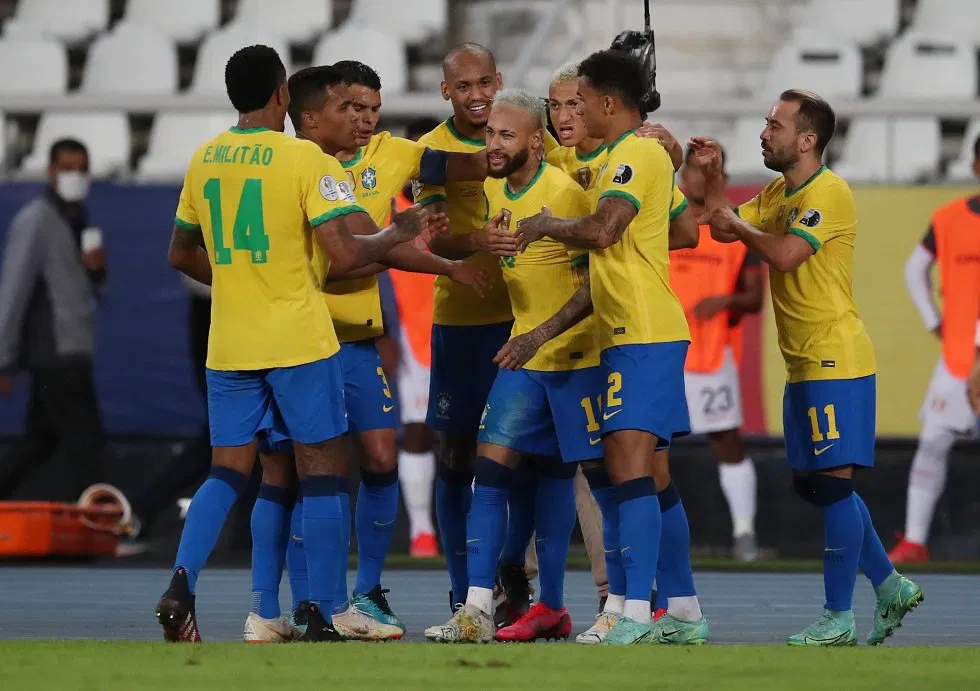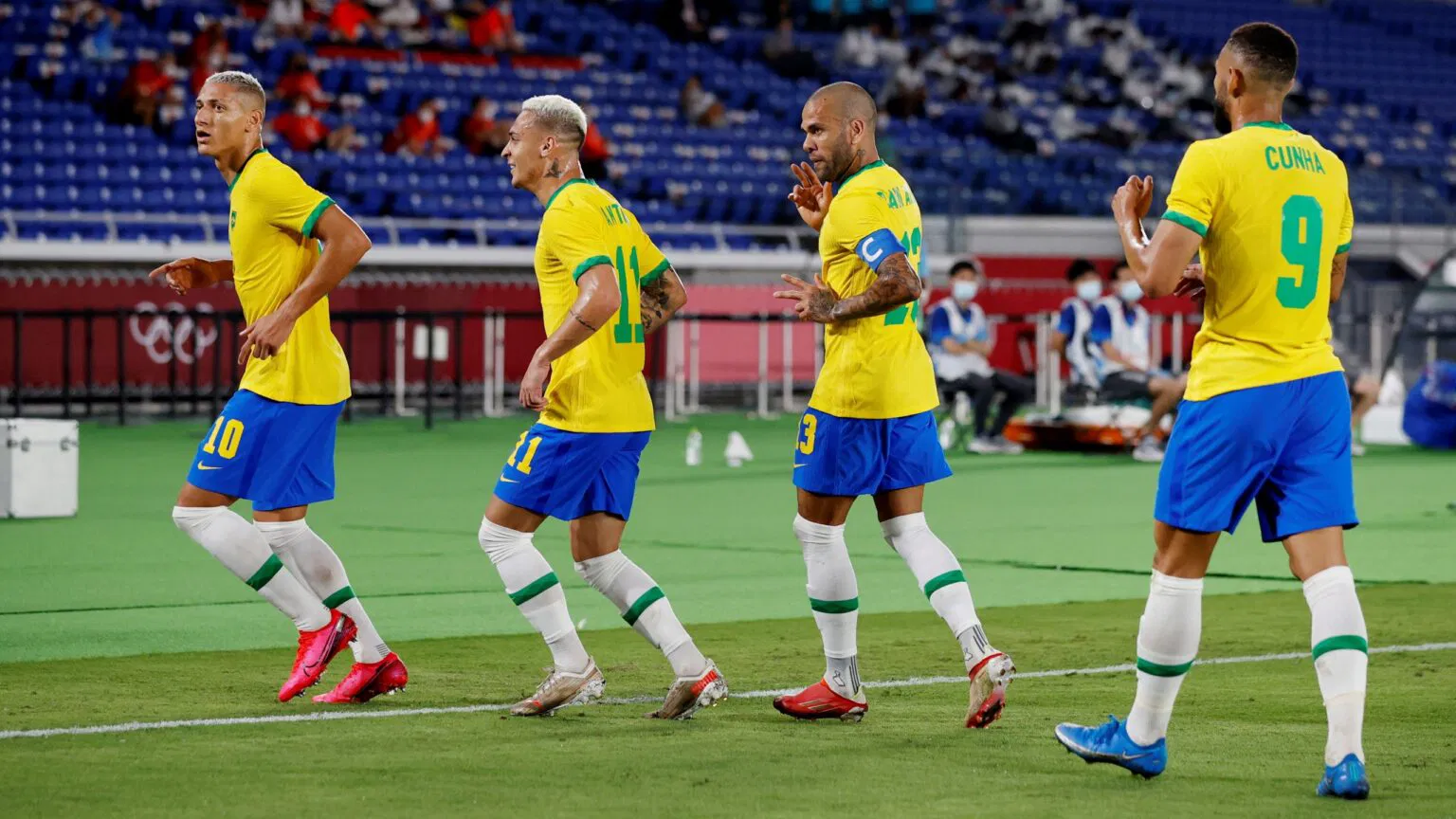Uruguay vs. Brazil The football rivalry between Uruguay and Brazil is legendary. Their encounters are eagerly awaited by fans worldwide. In their most recent World Cup qualifier, both teams showcased impressive lineups.
Brazil’s Starting Eleven
Brazil, known for its attacking flair, fielded a 4-3-3 formation:
Goalkeeper: Ederson stood between the posts, bringing his shot-stopping skills.
Defenders: Danilo and Abner occupied the flanks, with Marquinhos and Gabriel Magalhães às center-backs.
Midfielders: Gerson and Bruno Guimarães provided stability, while Savinho added creativity.
Forwards: Raphinha and Vinícius Júnior operated on the wings, supporting central striker Igor Jesus.
This lineup balanced experience and youth, aiming for both defensive solidity and attacking prowess.
Impact Players of the Match
Both teams showcased standout players who shaped the game’s momentum and outcome.
Brazil’s Key Performers:
Vinícius Júnior dazzled with his pace and trickery, frequently testing Uruguay’s defense.
Bruno Guimarães played a pivotal role in controlling the midfield, making critical interceptions.
Uruguay’s Game Changers:
Federico Valverde exhibited his versatility, breaking up attacks and launching counter-attacks effectively.
Darwin Núñez used his strength and agility to cause problems for Brazil’s defenders.
These players exemplified the skill and determination characteristic of this historic rivalry.
Game Highlights and Turning Points
This encounter was full of electrifying moments, making it an instant classic.
First Half Dominance:
Brazil started strong, utilizing their wingers to stretch Uruguay’s defense.
Uruguay’s goalkeeper, Sergio Rochet, made crucial saves to keep the game level.
Second Half Surge:
Uruguay adjusted their tactics, focusing on quick transitions and exploiting Brazil’s high defensive line.
Key substitutions from both sides brought fresh energy to the field, shifting momentum repeatedly.
The match showcased the resilience of both teams and their ability to adapt under pressure.
Coaches’ Strategies and Decisions
The tactical battle between the managers added another layer of intrigue.
Brazil’s Approach:
The coach emphasized offensive play, relying on quick passing and wing dominance.
The decision to start Ederson in goal highlighted their focus on ball distribution from the back.
Uruguay’s Game Plan:
Uruguay aimed to disrupt Brazil’s rhythm through aggressive pressing and midfield dominance.
The introduction of fresh legs in the second half demonstrated their adaptability and strategic depth.
Both managers received praise for their tactical awareness, despite the challenges posed by injuries.
Fans’ Reactions and Atmosphere
The atmosphere was electric, with fans from both nations passionately cheering their teams.
Uruguayan supporters turned their home ground into a fortress, creating an intimidating environment.
Brazilian fans, known for their vibrant chants and unwavering support, brought their energy as well.
Social media buzzed with reactions, celebrating the skill and effort displayed by both squads.
Historical Rivalry: A Legacy of Drama and Glory
Uruguay and Brazil share a football rivalry that transcends generations.
Memorable Matches:
From the “Maracanazo” to modern Copa América encounters, their matches are etched in football lore.
The rivalry reflects a mix of mutual respect and fierce competition, making every clash unforgettable.
Cultural Significance:
Football serves as a source of national pride for both nations, amplifying the stakes of each game.
This enduring rivalry is a testament to the passion and talent of South American football.

What’s Next for Uruguay and Brazil?
As the World Cup qualifiers progress, both teams aim to secure their spots in the tournament.
Brazil’s Focus:
They’ll continue refining their attacking play while addressing defensive vulnerabilities.
Players like Neymar’s potential return could significantly bolster their lineup.
Uruguay’s Goals:
Uruguay will look to build on their strong performance, focusing on consistent results.
The development of young talents like Núñez and Valverde remains crucial for their success.
Both nations are poised to make a strong impact on the international stage, driven by their rich footballing heritage.
Uruguay’s Starting Eleven
Uruguay, with its rich football heritage, opted for a 4-3-3 setup:
Goalkeeper: Sergio Rochet guarded the goal, known for his reliability.
Defenders: Varela and Saracchi played as full-backs, with José María Giménez and Matías Olivera in central defense.
Midfielders: Federico Valverde, Manuel Ugarte, and Rodrigo Bentancur formed a dynamic trio.
Forwards: Facundo Pellistri and Darwin Núñez flanked central forward Maximiliano Araújo.
This selection emphasized a blend of defensive resilience and midfield creativity.
Key Absences
Both teams faced notable absences due to injuries:
Brazil: Alisson, Guilherme Arana, and Neymar were sidelined.
Uruguay: Nicolás de la Cruz and Giorgian de Arrascaeta missed out.
These absences required tactical adjustments from both coaches.
Tactical Approaches
Brazil’s strategy focused on wing play, utilizing the speed of Raphinha and Vinícius Júnior. The midfield aimed to control possession and dictate the game’s tempo.
Uruguay sought to disrupt Brazil’s rhythm with high pressing. Valverde and Bentancur were pivotal in transitioning from defense to attack.
Historical Context
Matches between Uruguay and Brazil are steeped in history. From the 1950 World Cup’s “Maracanazo” to recent Copa América clashes, their encounters are always intense.
The latest matchup between Uruguay and Brazil highlighted their tactical depth and talent. Both teams, despite missing key players, delivered a performance worthy of their storied rivalry.
FAQs
Q: Who were the key players missing due to injury?
A: Brazil missed Alisson, Guilherme Arana, and Neymar. Uruguay was without Nicolás de la Cruz and Giorgian de Arrascaeta.
Q: What formations did the teams use?
A: Both teams employed a 4-3-3 formation.
Q: Who was Brazil’s goalkeeper in this match?
A: Ederson was Brazil’s goalkeeper.
Q: Which players formed Uruguay’s midfield trio?
A: Guide Federico Valverde, Manuel Ugarte, and Rodrigo Bentancur.
Q: What is the historical significance of Uruguay vs. Brazil matches?
A: Their matches are historic, notably the 1950 World Cup’s “Maracanazo.”
Q: Who were the standout players in this match?
A: Vinícius Júnior and Federico Valverde were among the top performers.
Q: What was the atmosphere like during the game?
A: The crowd was electric, with fans passionately supporting their teams.
Q: How did Uruguay adapt their tactics in the second half?
A: They focused on quick transitions and exploiting Brazil’s defensive gaps.
Q: What is the historical significance of this rivalry?
A: Atalanta It reflects decades of competitive football, marked by legendary matches.
To read more, Click Here

Leave a Reply